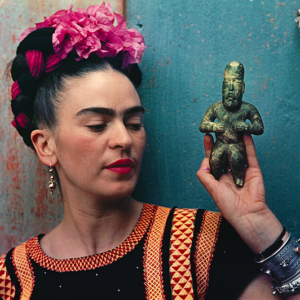
(1907-1954) is the most famous Mexican woman artist on the contemporary art scene. In our society, where the media focus is on sex and violence, certain autobiographical elements of Kahlo’s life–her physical handicaps (as a result of an accident when she was eighteen), her marriage with the world famous muralist Diego Rivera, her husband’s infidelities, Kahlo’s affairs (both with men and women), and her unhappiness at not being able to bear a child–provoke psychological discussions of her work.
On the other hand, Kahlo’s communist politics and their impact on her art are either ignored or trivialized. Janice Helland, a Canadian art professor art history, one of the more preceptive writers on the artist, observes that establishing Kahlo only as tragic and exotic figure results in whitewashing the “bloody, brutal, and overtly political content” of her art production.
When Kahlo died in 1954, her work was only familiar to a small group of people in Mexico and the United States. With the 1983 publication of Hayden Herrera’s book, Frida: A Biography of Frida Kahlo the first and probably most widely read monograph on the artist in the United States, the response to Kahlo’s life and art has been overwhelming…
Herrera shows the artist triumphant over life’s problems through the strength of her individual will and effort…
Books, countless articles (both popular and scholarly), exhibitions, and catalogs have followed in the United States, England, Germany, Australia and Japan. The Marxist Kahlo has been transformed into a cultural icon for the nineties.
Kahlo painted the feminine reality which makes visible so much that has remained hidden in women’s lives. Although these concepts were clearly not part of Kahlo’s consciousness, much of her work is a visualization of the theme that the personal is political…
Kahlo’s art and life often reveals the ongoing struggle for self-determination in the lives of women. Kahlo forged an identity in her paintings outside the strictures of her society. Her art deals with conception, pregnancy, abortion and gender roles in a un unusually frank and open manner, thus making them political statements because women have not generally felt free to address such personal subjects so publicly. The artist’s life and art, then, appeals not only to feminist scholars but a wide general audience of women as well as men…
An appropriate discussion of Kahlo’s art must bridge the gap between her private and public lives. Kahlo’s work and life have to be analyzed in such a way as to tie together her political convictions and the painful and personal experiences recorded in her paintings. In painting her personal reality, Kahlo created arresting visual documents about the experiences of being a woman at a particular place and time. The strength that allowed her to paint as she did was derived from her philosophical beliefs, along with her conscious femininity, allowing her to look at the world with a new and critical light.
A Socialist, Feminist, Anti-Racist Organization: Solidarity. Kahlo As Artist, Woman, Rebel by Mary Motian-Meadows